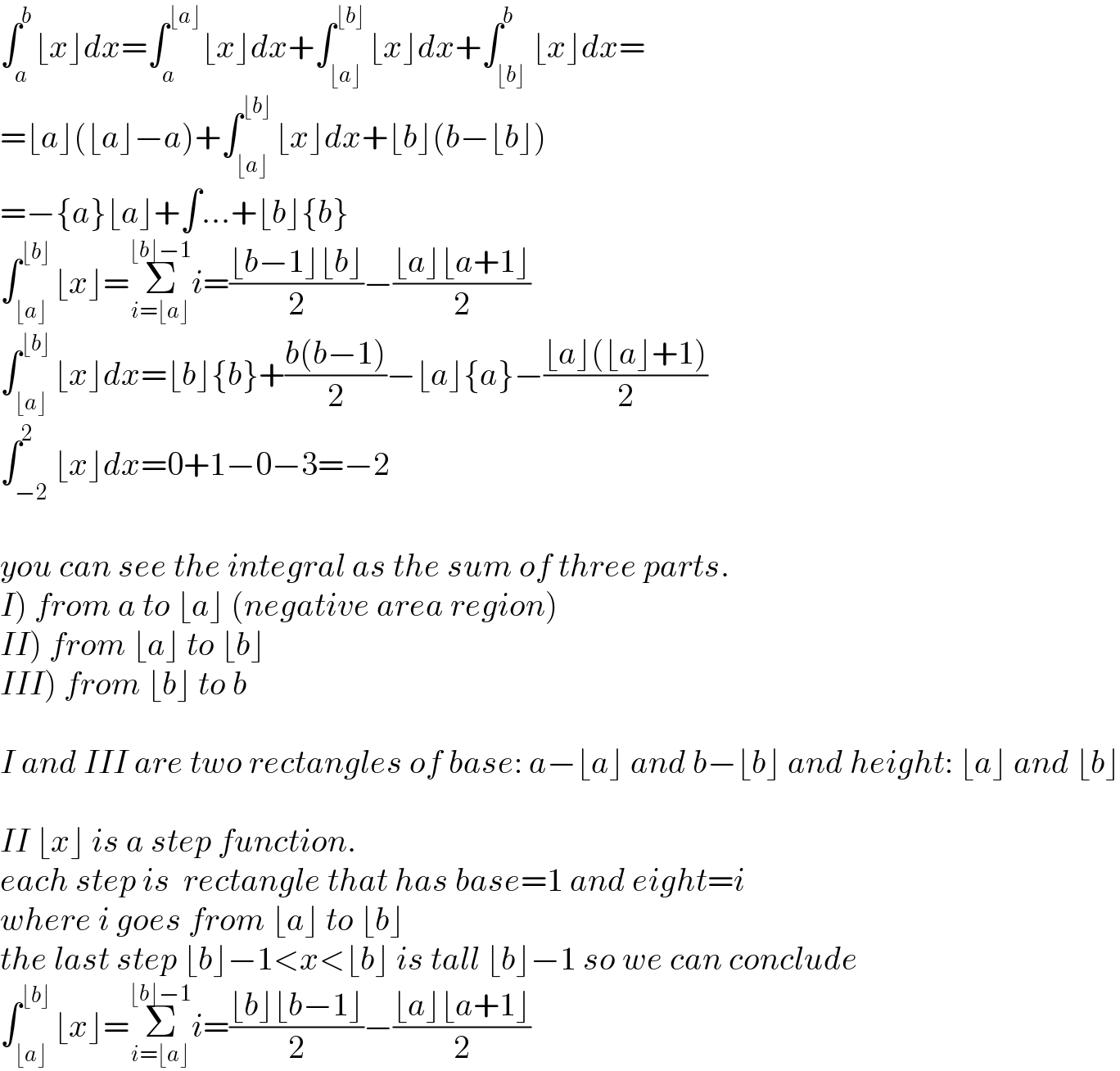
Question Number 164929 by mathlove last updated on 23/Jan/22
![∫_(−2) ^2 [x]dx=?](Q164929.png)
$$\underset{−\mathrm{2}} {\overset{\mathrm{2}} {\int}}\left[{x}\right]{dx}=? \\ $$
Answered by TheSupreme last updated on 23/Jan/22

$$\int_{{a}} ^{{b}} \lfloor{x}\rfloor{dx}=\int_{{a}} ^{\lfloor{a}\rfloor} \lfloor{x}\rfloor{dx}+\int_{\lfloor{a}\rfloor} ^{\lfloor{b}\rfloor} \lfloor{x}\rfloor{dx}+\int_{\lfloor{b}\rfloor} ^{{b}} \lfloor{x}\rfloor{dx}= \\ $$$$=\lfloor{a}\rfloor\left(\lfloor{a}\rfloor−{a}\right)+\int_{\lfloor{a}\rfloor} ^{\lfloor{b}\rfloor} \lfloor{x}\rfloor{dx}+\lfloor{b}\rfloor\left({b}−\lfloor{b}\rfloor\right) \\ $$$$=−\left\{{a}\right\}\lfloor{a}\rfloor+\int...+\lfloor{b}\rfloor\left\{{b}\right\} \\ $$$$\int_{\lfloor{a}\rfloor} ^{\lfloor{b}\rfloor} \lfloor{x}\rfloor=\underset{{i}=\lfloor{a}\rfloor} {\overset{\lfloor{b}\rfloor−\mathrm{1}} {\sum}}{i}=\frac{\lfloor{b}−\mathrm{1}\rfloor\lfloor{b}\rfloor}{\mathrm{2}}−\frac{\lfloor{a}\rfloor\lfloor{a}+\mathrm{1}\rfloor}{\mathrm{2}} \\ $$$$\int_{\lfloor{a}\rfloor} ^{\lfloor{b}\rfloor} \lfloor{x}\rfloor{dx}=\lfloor{b}\rfloor\left\{{b}\right\}+\frac{{b}\left({b}−\mathrm{1}\right)}{\mathrm{2}}−\lfloor{a}\rfloor\left\{{a}\right\}−\frac{\lfloor{a}\rfloor\left(\lfloor{a}\rfloor+\mathrm{1}\right)}{\mathrm{2}} \\ $$$$\int_{−\mathrm{2}} ^{\mathrm{2}} \lfloor{x}\rfloor{dx}=\mathrm{0}+\mathrm{1}−\mathrm{0}−\mathrm{3}=−\mathrm{2} \\ $$$$ \\ $$$${you}\:{can}\:{see}\:{the}\:{integral}\:{as}\:{the}\:{sum}\:{of}\:{three}\:{parts}. \\ $$$$\left.{I}\right)\:{from}\:{a}\:{to}\:\lfloor{a}\rfloor\:\left({negative}\:{area}\:{region}\right)\: \\ $$$$\left.{II}\right)\:{from}\:\lfloor{a}\rfloor\:{to}\:\lfloor{b}\rfloor \\ $$$$\left.{III}\right)\:{from}\:\lfloor{b}\rfloor\:{to}\:{b} \\ $$$$ \\ $$$${I}\:{and}\:{III}\:{are}\:{two}\:{rectangles}\:{of}\:{base}:\:{a}−\lfloor{a}\rfloor\:{and}\:{b}−\lfloor{b}\rfloor\:{and}\:{height}:\:\lfloor{a}\rfloor\:{and}\:\lfloor{b}\rfloor \\ $$$$ \\ $$$${II}\:\lfloor{x}\rfloor\:{is}\:{a}\:{step}\:{function}. \\ $$$${each}\:{step}\:{is}\:\:{rectangle}\:{that}\:{has}\:{base}=\mathrm{1}\:{and}\:{eight}={i} \\ $$$${where}\:{i}\:{goes}\:{from}\:\lfloor{a}\rfloor\:{to}\:\lfloor{b}\rfloor \\ $$$${the}\:{last}\:{step}\:\lfloor{b}\rfloor−\mathrm{1}<{x}<\lfloor{b}\rfloor\:{is}\:{tall}\:\lfloor{b}\rfloor−\mathrm{1}\:{so}\:{we}\:{can}\:{conclude} \\ $$$$\int_{\lfloor{a}\rfloor} ^{\lfloor{b}\rfloor} \lfloor{x}\rfloor=\underset{{i}=\lfloor{a}\rfloor} {\overset{\lfloor{b}\rfloor−\mathrm{1}} {\sum}}{i}=\frac{\lfloor{b}\rfloor\lfloor{b}−\mathrm{1}\rfloor}{\mathrm{2}}−\frac{\lfloor{a}\rfloor\lfloor{a}+\mathrm{1}\rfloor}{\mathrm{2}} \\ $$
Commented by mathlove last updated on 23/Jan/22

$${thanks}\:\:\:{sir} \\ $$
Answered by Ar Brandon last updated on 23/Jan/22
![I=∫_(−2) ^2 [x]dx=Σ_(k=−2) ^1 ∫_k ^(k+1) kdx=Σ_(k=−2) ^1 k =−2−1+0+1=−2](Q164932.png)
$${I}=\int_{−\mathrm{2}} ^{\mathrm{2}} \left[{x}\right]{dx}=\underset{{k}=−\mathrm{2}} {\overset{\mathrm{1}} {\sum}}\int_{{k}} ^{{k}+\mathrm{1}} {kdx}=\underset{{k}=−\mathrm{2}} {\overset{\mathrm{1}} {\sum}}{k} \\ $$$$\:\:\:=−\mathrm{2}−\mathrm{1}+\mathrm{0}+\mathrm{1}=−\mathrm{2} \\ $$
Commented by mathlove last updated on 23/Jan/22

$${thanks} \\ $$
Answered by TheSupreme last updated on 23/Jan/22
![∫_0 ^x {t}dt=((⌊x⌋+{x}^2 )/2) ∫_0 ^x t−{t}=(x^2 /2)−(([x]+{x}^2 )/2)= =((x^2 −{x}^2 −[x])/2)=(([x](x+{x})−[x])/2)= =[x]((x+{x}−1)/2) =2+0−1−2−1=−2 if {x}=0 ⌊x⌋((x−1)/2)](Q164943.png)
$$\int_{\mathrm{0}} ^{{x}} \left\{{t}\right\}{dt}=\frac{\lfloor{x}\rfloor+\left\{{x}\right\}^{\mathrm{2}} }{\mathrm{2}} \\ $$$$\int_{\mathrm{0}} ^{{x}} {t}−\left\{{t}\right\}=\frac{{x}^{\mathrm{2}} }{\mathrm{2}}−\frac{\left[{x}\right]+\left\{{x}\right\}^{\mathrm{2}} }{\mathrm{2}}= \\ $$$$=\frac{{x}^{\mathrm{2}} −\left\{{x}\right\}^{\mathrm{2}} −\left[{x}\right]}{\mathrm{2}}=\frac{\left[{x}\right]\left({x}+\left\{{x}\right\}\right)−\left[{x}\right]}{\mathrm{2}}= \\ $$$$=\left[{x}\right]\frac{{x}+\left\{{x}\right\}−\mathrm{1}}{\mathrm{2}} \\ $$$$=\mathrm{2}+\mathrm{0}−\mathrm{1}−\mathrm{2}−\mathrm{1}=−\mathrm{2} \\ $$$$ \\ $$$${if}\:\left\{{x}\right\}=\mathrm{0} \\ $$$$\lfloor{x}\rfloor\frac{{x}−\mathrm{1}}{\mathrm{2}} \\ $$
